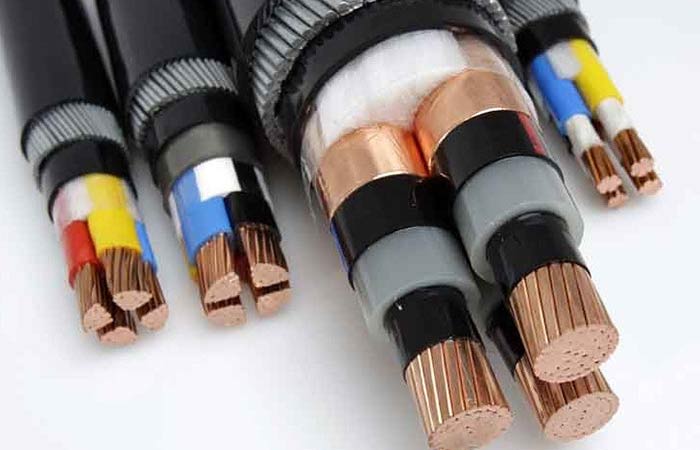The insulation material of wire and cable is an important structure to ensure the proper operation of the conductor. The operating life of the insulation material is an important indicator of the life of the cable. Usually, what are the insulation materials we use for wire and cable?

Polyvinyl chloride (PVC)
1) Main advantages: low price, easy process, light quality, good electrical performance, corrosion resistance, stable chemical properties, moisture resistance, and non-retarded combustion. Therefore, it is widely used in low-voltage distribution lines, especially in the terminal circuit, as the basic insulation and sheathing material.
(2) The maximum continuous working temperature θn of PVC insulated cable is 70°C, while the final temperature (short-circuit transient temperature) θm is 160°C (140°C for the cross-sectional area of 300m㎡ and above). In addition, there are PVC materials with heat-resistant plasticizers added, whose θn can reach 90℃, but θm remains unchanged.
(3) Main disadvantages: It is not suitable for the low-temperature environment, it becomes hard and brittle at low temperature, and cannot be used in the environment below -15℃, and it is not suitable for construction in the environment below -5℃. PVC emits toxic gas when it burns, so the application range is greatly restricted. It is poorly adapted to atmospheric aging conditions, and under strong sunlight or a high-temperature environment, the plasticizer is easy to volatilize to accelerate the aging of insulation.
(4) In order to overcome the shortcomings of PVC, it is usually necessary to add a variety of polymers to improve its performance, such as the addition of plasticizers to increase the softness. Plasticizers were added to antimony trioxide and chlorinated paraffin to increase the flame retardant properties. Molybdenum chloride is added to reduce the amount of smoke generation. Different additive formulations, and different molding process methods, but also can produce a variety of derivative products. Such as increased flexibility, increased rigidity, improved wear resistance, and can increase the working temperature up to 90 ℃ of a variety of products.
Cross-linked polyethylene (XLPE)
(1) Cross-linked polyethylene is a process method in which polyethylene (PE) materials with a linear molecular structure are cross-linked into a three-dimensional reticulated molecular structure by cross-linking agents and radiation or electron beam bombardment. At present, there are two types of cross-linking, chemical cross-linking and irradiation cross-linking. Irradiation cross-linking can maintain good electrical properties and flame retardant properties and stable quality, which is the better cross-linking method at present.
(2) The main advantages: are good insulation performance, high current carrying capacity, low dielectric loss, lighter quality, corrosion resistance, moisture resistance, cold resistance, does not contain halogen, burning does not emit a lot of toxic fumes.
(3) The maximum continuous working temperature θn is 90℃ and the final temperature θm is 250℃, which is obviously better than insulating materials such as PVC and rubber.
4) Ordinary cross-linked polyethylene by chemical cross-linking method does not have flame retardant performance, and it needs to add flame retardant, but then it will reduce the mechanical and electrical properties. XLPE is more sensitive to ultraviolet radiation and should not be used outdoor and in places with strong sunlight, otherwise, it should have sheathing or protective measures.
Ethylene propylene rubber (EPR): that is, cross-linked ethylene—propylene rubber
(1) Main advantages: high load capacity, no halogen, will not emit a lot of smoke when burning. Also has flame retardant properties. Has the stability of ozone resistance. Can be used in a low-temperature environment of -50℃.
2) The continuous maximum working temperature θn is 90℃, and the final temperature θm is 250℃, which is the same as XLPE.
(3) This insulation material has been widely used in Europe.
Rubber Insulation
(1) characteristics: the rubber used for wire and cable insulation, more than natural pure rubber, but from pure rubber and a variety of additives and fillers mixed, at a certain temperature, pressure, vulcanization process made of elastomer; rubber flexibility, elasticity, and tensile strength are better; in the 1970s before the low-voltage distribution line cloth wire insulation materials, after gradually replaced by PVC and other materials; nowadays (1) Characteristics: The rubber used for wire and cable insulation is mostly not natural pure rubber, but an elastomer made of pure rubber mixed with various additives and fillers and vulcanized under certain temperature and pressure. The softness, elasticity, and tensile strength of rubber are better. Before the 1970s, it was the main insulating material for low-voltage distribution lines and wires and was gradually replaced by PVC and other materials. Nowadays, it is mainly used as a rubber-sheathed flexible cable for mobile equipment and handheld electrical applications.
(2) the maximum continuous working temperature θn is 60 ℃, the final temperature θm is 200 ℃, for low-voltage wire and cable insulation, sheathing. There is also neoprene, θn up to 85 ℃, θm for 220 ℃, mainly used for outdoor cable sheathing. There is also silicone rubber, θn up to 185 ℃, θm for 350 ℃, as a special high-temperature lead, H-class insulation motor lead wire and marine high-temperature cable, etc.
(3) rubber insulation materials wire and cable with a small load capacity, aging resistance, oil resistance, and solvent resistance performance are poor. In order to improve the performance of rubber, a variety of rubber polymers have many advantages, such as neoprene rubber weather resistance, oil resistance, wear resistance, good flame retardant properties, and suitable for cable sheathing. Nitrile rubber oil resistance, good corrosion resistance, used for oil pump motor and electrical equipment lead wire. Silicone rubber has high-temperature resistance, high tensile strength, and good electrical properties, used for high-temperature equipment lead wire. Fluorine rubber heat resistance, oil resistance, weather resistance, good performance, used for special cable sheathing.


